并列连词和从属连词全版.docx
- 格式:docx
- 大小:18.95 KB
- 文档页数:14
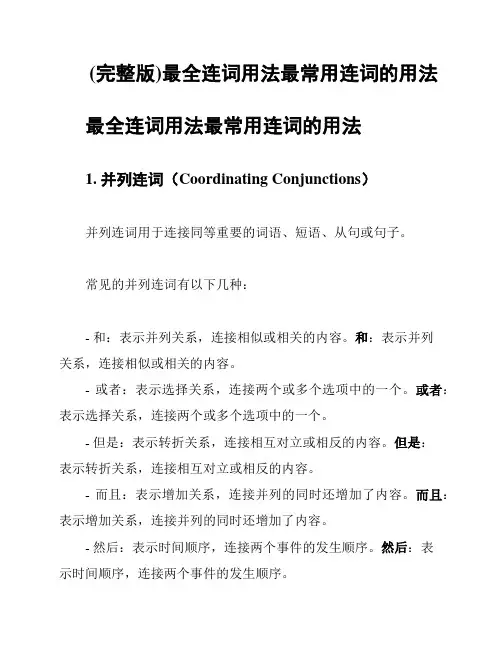
(完整版)最全连词用法最常用连词的用法最全连词用法最常用连词的用法1. 并列连词(Coordinating Conjunctions)并列连词用于连接同等重要的词语、短语、从句或句子。
常见的并列连词有以下几种:- 和:表示并列关系,连接相似或相关的内容。
和:表示并列关系,连接相似或相关的内容。
- 或者:表示选择关系,连接两个或多个选项中的一个。
或者:表示选择关系,连接两个或多个选项中的一个。
- 但是:表示转折关系,连接相互对立或相反的内容。
但是:表示转折关系,连接相互对立或相反的内容。
- 而且:表示增加关系,连接并列的同时还增加了内容。
而且:表示增加关系,连接并列的同时还增加了内容。
- 然后:表示时间顺序,连接两个事件的发生顺序。
然后:表示时间顺序,连接两个事件的发生顺序。
- 因为:表示原因关系,连接原因和结果。
因为:表示原因关系,连接原因和结果。
2. 递进连词(Conjunctive Adverbs)递进连词用于表示递进、推理、解释或转折关系。
常见的递进连词有以下几种:- 此外:表示补充信息。
此外:表示补充信息。
- 而且 / 并且:表示增加的内容。
而且 / 并且:表示增加的内容。
- 然而 / 可是:表示转折或对比的内容。
然而 / 可是:表示转折或对比的内容。
- 因此 / 所以:表示因果或结果的关系。
因此 / 所以:表示因果或结果的关系。
- 不仅如此:表示更进一步的内容。
不仅如此:表示更进一步的内容。
3. 从属连词(Subordinating Conjunctions)从属连词用于引导从句,表达主句与从句之间的关系。
常见的从属连词有以下几种:- 如果:表示条件关系,引导条件从句。
如果:表示条件关系,引导条件从句。
- 当:表示时间关系,引导时间从句。
当:表示时间关系,引导时间从句。
- 因为:表示原因关系,引导原因从句。
因为:表示原因关系,引导原因从句。
- 所以:表示结果关系,引导结果从句。
所以:表示结果关系,引导结果从句。
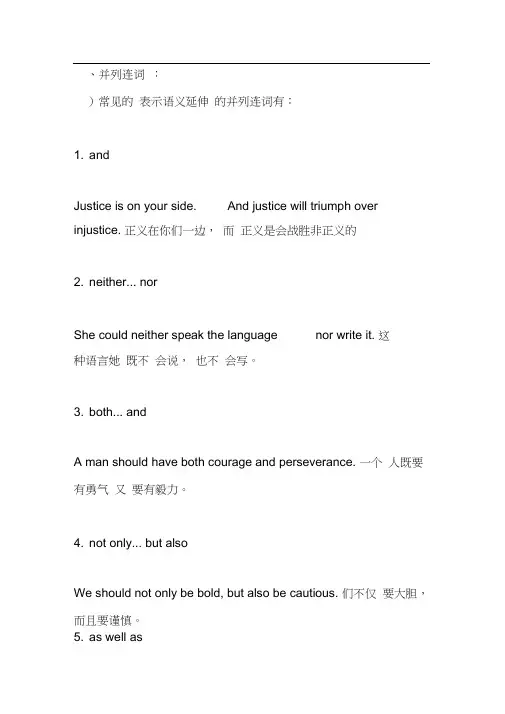
、并列连词:)常见的表示语义延伸的并列连词有:1. andJustice is on your side. And justice will triumph over injustice. 正义在你们一边,而正义是会战胜非正义的2. neither... norShe could neither speak the language nor write it. 这种语言她既不会说,也不会写。
3. both... andA man should have both courage and perseverance. 一个人既要有勇气又要有毅力。
4. not only... but alsoWe should not only be bold, but also be cautious. 们不仅要大胆,而且要谨慎。
5. as well asI have read one of his novels as well as a few of his plays. 我读过他的一本小说和几个剧本。
二)表示选择的并列连词有:1. orYou may do it yourself, or ask someone else to do it. 你可以自己做或者让别人做。
2. either... orI left it either on the table or in the drawer. 我不是把它放在桌子上了,就是放在抽屉里了。
除了表示选择外,or 和either... or 还可以表示否定的条件:1) Now I must go or (if not) I shall be late for theparty. 我现在得走了,否则晚会我就要迟到了2) You'll either behave yourself, or you'll never goout with me. 你要么老实点,要么就永远不能跟我一起出去。
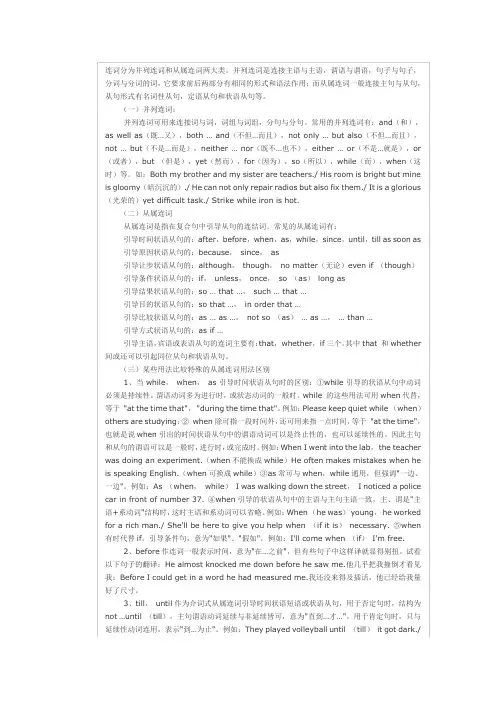
语法填空答题规律一、命题揭秘材料短文特点(1)短文体裁:近三年都是记叙文。
建议:备考练习不局限于此应各种体裁的文章都要练习。
(2)短文题材:生活经历或成语故事,其内容或体现文化内涵,或给人心灵以启迪等。
(3)短文难度:没有超出课标的生词,但有课标单词的派生词。
(4)短文长度:170——200词。
考试大纲说明阅读下面短文, 按照句子结构的语法性和上下文连贯的要求, 在空格处填入一个适当的词或使用括号中词语的正确形式填空, 并将答案填写在答题卡标号为31~40的相应位置上.2009年语法填空本文讲叙Jane在圣诞节给父亲选礼物,因往年送父亲领带不能使父亲高兴,满以为这次买烟斗送父亲会让父亲高兴的,买回来后却被告知父亲戒烟了。
Jane was walking round the department store. She remembered how difficult 31 was to choose a suitable Christmas present for her father. She wished that he was as easy 32 (please) as her mother, who was always delighted with perfume.31. it。
在宾语从句中作形式主语,真正的主语是to choose…。
32. to please。
在形容词后作状语,只能用动词不定式,且用主动形式表示被动含义。
Besides, shopping at this time of the year was not 33 pleasant experience: people stepped on your feet or 34 (push) you with their elbows (肘部), hurrying ahead to get to a bargain.Jane paused in front of a counter 35 some attractive ties were on display. “They are real silk,” the assistant tried to attract her. “Worth double the price.” But Jane knew from past experience that her 36 (choose) of ties hardly ever pleased her father.33. a。
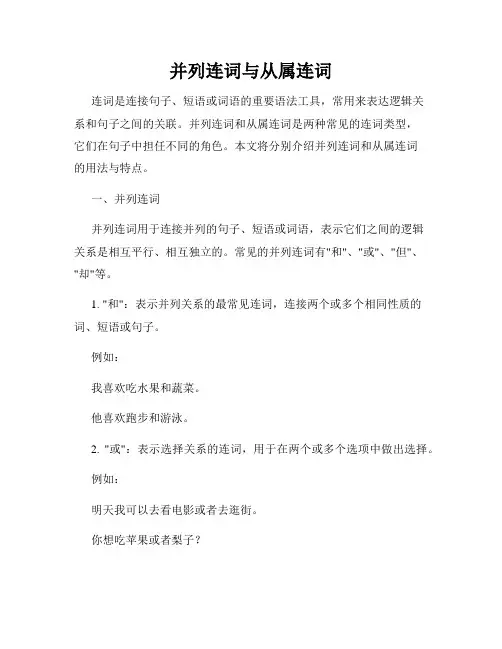
并列连词与从属连词连词是连接句子、短语或词语的重要语法工具,常用来表达逻辑关系和句子之间的关联。
并列连词和从属连词是两种常见的连词类型,它们在句子中担任不同的角色。
本文将分别介绍并列连词和从属连词的用法与特点。
一、并列连词并列连词用于连接并列的句子、短语或词语,表示它们之间的逻辑关系是相互平行、相互独立的。
常见的并列连词有"和"、"或"、"但"、"却"等。
1. "和":表示并列关系的最常见连词,连接两个或多个相同性质的词、短语或句子。
例如:我喜欢吃水果和蔬菜。
他喜欢跑步和游泳。
2. "或":表示选择关系的连词,用于在两个或多个选项中做出选择。
例如:明天我可以去看电影或者去逛街。
你想吃苹果或者梨子?3. "但":表示转折关系的连词,常用于表示对比、相反或不同的情况。
例如:他很聪明,但不努力学习。
虽然天气很热,但我还是要去锻炼身体。
4. "却":表示意外或出乎意料的情况,强调转折关系。
例如:他原本想请假旅行,结果却生病了。
虽然她很努力,却没有得到应有的荣誉。
二、从属连词从属连词用于连接主从句,表示两个句子之间的从属关系。
常见的从属连词有"因为"、"所以"、"虽然"、"如果"等。
1. "因为":表示原因或理由的从属连词,用于引导原因状语从句。
例如:我喜欢你,因为你很善良。
他没有参加聚会,因为他要加班。
2. "所以":表示结果或推论的从属连词,用于引导结果状语从句。
例如:我努力学习,所以考试取得了好成绩。
他在公司表现出色,所以得到了晋升的机会。
3. "虽然":表示尽管或让步的从属连词,用于引导让步状语从句。
例如:虽然下雨了,但是我们还是去了公园。
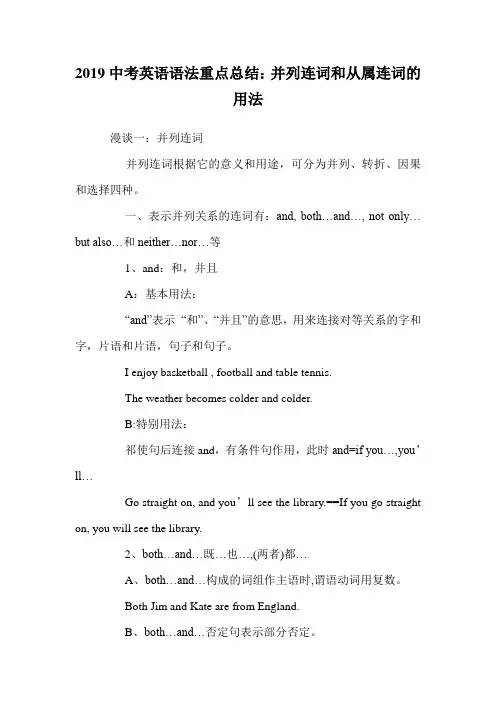
2019中考英语语法重点总结:并列连词和从属连词的用法漫谈一:并列连词并列连词根据它的意义和用途,可分为并列、转折、因果和选择四种。
一、表示并列关系的连词有:and, both…and…, not only… but also…和neither…nor…等1、and:和,并且A:基本用法:“and”表示“和”、“并且”的意思,用来连接对等关系的字和字,片语和片语,句子和句子。
I enjoy basketball , football and table tennis.The weather becomes colder and colder.B:特别用法:祁使句后连接and,有条件句作用,此时and=if you…,you’ll…Go straight on, and you’ll see the library.==If you go straight on, you will see the library.2、both…and…既…也…,(两者)都…A、both…and…构成的词组作主语时,谓语动词用复数。
Both Jim and Kate are from England.B、both…and…否定句表示部分否定。
You can’t speak both German and English.Both my father and my mother aren’t doctors.3、neither…nor…:既不…也不…neither…nor…连接两个并列主语时,谓语动词靠近哪个主语就与哪个主语保持“人称”和“数”的一致,即采取就近原则。
Neither I nor he has seen the play before.4、not only…but also…:不但…而且…not only…but also…连接两个主语后的谓语动词也遵循就近原则。
Not only the mother but also the children are ill.二、表示转折关系的连词有:but, however, yet, still,while等。
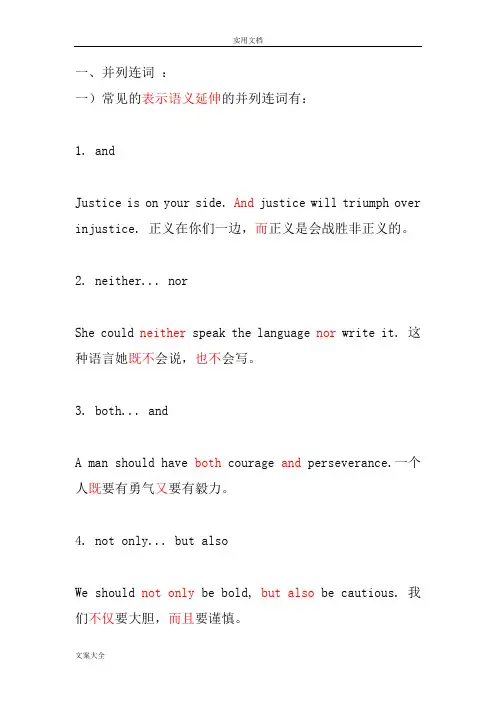
一、并列连词:一)常见的表示语义延伸的并列连词有:1. andJustice is on your side. And justice will triumph over injustice. 正义在你们一边,而正义是会战胜非正义的。
2. neither... norShe could neither speak the language nor write it. 这种语言她既不会说,也不会写。
3. both... andA man should have both courage and perseverance.一个人既要有勇气又要有毅力。
4. not only... but alsoWe should not only be bold, but also be cautious. 我们不仅要大胆,而且要谨慎。
5. as well asI have read one of his novels as well as a few of his plays. 我读过他的一本小说和几个剧本。
二)表示选择的并列连词有:1. orYou may do it yourself, or ask someone else to do it. 你可以自己做或者让别人做。
2. either... orI left it either on the table or in the drawer. 我不是把它放在桌子上了,就是放在抽屉里了。
除了表示选择外,or和either... or还可以表示否定的条件:1) Now I must go or (if not) I shall be late for theparty. 我现在得走了,否则晚会我就要迟到了。
2) You'll either behave yourself, or you'll never go out with me. 你要么老实点,要么就永远不能跟我一起出去。
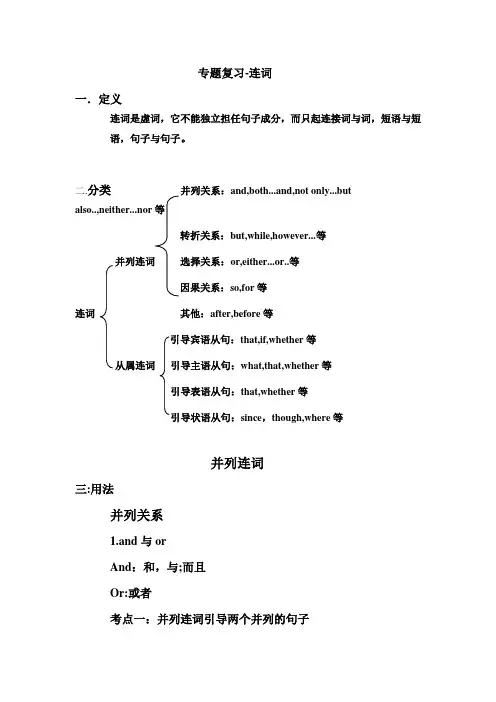
专题复习-连词一.定义连词是虚词,它不能独立担任句子成分,而只起连接词与词,短语与短语,句子与句子。
二.分类and,both...and,not only...butalso..,neither...norbut,while,however...等or,either...or..等so,for等连词其他:after,before等that,if,whether等从属连词what,that,whether等that,whether等since,though,where等并列连词三:用法并列关系1.and与orAnd:和,与;而且Or:或者考点一:并列连词引导两个并列的句子判断改错:(1)They sat down and talk about some thing.()(2)They started to dance and sang.()(3)I saw two men sitting behind and whisper there.()(4)They started to dance and sing.()(5)I saw two men sitting behind and whispering there.() 考点二:and与or在祈使句中的应用。
Eg;Make your mind,and you`ll get the chance.One more effort,and you`ll succeed.Do it now,or you`ll miss the opportunity.Beg your father,or he will beat you.考点三:and与or在意义上的区别Your father_______my father are good friends.Do it______not,it`s up to you.1.both...and... 两者都She can speak both English and Chinese.2.Not only...but also...=as well as...注意:not only..but also连接两个分句时,第一个分句用到装(原因否定词位于句首)Not only does he like reading stories,but also he can even write some.3.Neither...nor既不...也不....Neither you nor he is to blame.4.Either...or或者...或者...转折关系6.but与while转折和对比Some people love cats,while others hate them.试一试:Would you like to come to dinner tonight?I`d like to,__________I`m too busy.7.Not...but..不是...而是...They were not the bones of an animal,but(the bones)of a human being.原因关系8.for与becauseBecause+句子,常位于句首for放于两个分句之间,前面常有逗号隔开练习:判断对错1.For he is ill,he is absent today.()2.He is absent today,for he is ill.()3.I can not sleep because I am too excited.()注意:(1).for引导的从句不能位于它所解释的动词之前。
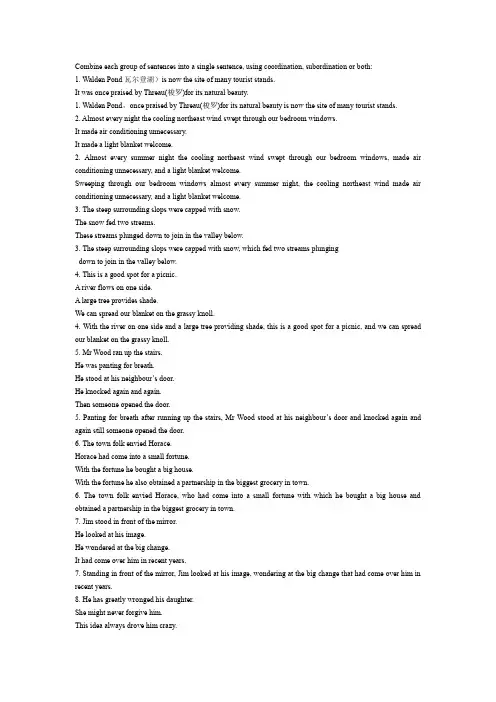
Combine each group of sentences into a single sentence, using coordination, subordination or both:1. Walden Pond瓦尔登湖)is now the site of many tourist stands.It was once praised by Threau(梭罗)for its natural beauty.1. Walden Pond,once praised by Threau(梭罗)for its natural beauty is now the site of many tourist stands.2. Almost every night the cooling northeast wind swept through our bedroom windows.It made air conditioning unnecessary.It made a light blanket welcome.2. Almost every summer night the cooling northeast wind swept through our bedroom windows, made air conditioning unnecessary, and a light blanket welcome.Sweeping through our bedroom windows almost every summer night, the cooling northeast wind made air conditioning unnecessary, and a light blanket welcome.3. The steep surrounding slops were capped with snow.The snow fed two streams.These streams plunged down to join in the valley below.3. The steep surrounding slops were capped with snow, which fed two streams plungingdown to join in the valley below.4. This is a good spot for a picnic.A river flows on one side.A large tree provides shade.We can spread our blanket on the grassy knoll.4. With the river on one side and a large tree providing shade, this is a good spot for a picnic, and we can spread our blanket on the grassy knoll.5. Mr Wood ran up the stairs.He was panting for breath.He stood at his neighbour’s door.He knocked again and again.Then someone opened the door.5. Panting for breath after running up the stairs, Mr Wood stood at his neighbour’s door and knocked again and again still someone opened the door.6. The town folk envied Horace.Horace had come into a small fortune.With the fortune he bought a big house.With the fortune he also obtained a partnership in the biggest grocery in town.6. The town folk envied Horace, who had come into a small fortune with which he bought a big house and obtained a partnership in the biggest grocery in town.7. Jim stood in front of the mirror.He looked at his image.He wondered at the big change.It had come over him in recent years.7. Standing in front of the mirror, Jim looked at his image, wondering at the big change that had come over him in recent years.8. He has greatly wronged his daughter.She might never forgive him.This idea always drove him crazy.8. The idea that his only daughter whom e had greatly wronged might never forgive him almost drove him mad.9. The story is written in plain language.It consists of three parts.It has an interesting plot.The plot centres round an old aristocratic family.The family lived in 17thc entry France.9. The story, written in plain language, consists of three parts with an interesting plot centring round an aristocratic family living in 17th-centry France.10. John was covered with mud.He was shivering.He sat hunched over a bowl of hot broth.The broth had been prepared by his father to drive off the chill.10. Mud-covered and shivering, John sat hunched over a bowl of hot broth prepared by his father to drive off the chill.11.Far above the waters of a beautiful lake stand five pavilions.The pavilions are in Chinese style.They stand over the tops of the tall pine trees.The pine trees grow on the steep slopes of a hill.11. Far above the waters of a beautiful lake and over the tops of the tall pine trees growing on the steep slopes of a hill stand five Chinese-style pavilions.12. The old man stopped farther down the street.He leaned against a lamp-post.He listened to a song.The song was cheerful.It came out from a restaurant.The restaurant was on the opposite side of the street.12. Farther down the street, the old man stopped and leaned against a lamp-post, listening to a cheerful song coming out of a restaurant on the opposite side of the street.13. Sarah sank in the nearest chair.She is completely exhausted.Her limbs were stiff with cold.Her mind was a piece of blank.13 Sarah sank in the nearest chair, completely exhausted, her limbs stiff with cold, her mind a piece of blank.14. Mrs Rymer behaved properly throughout the day.Her pleasant, refined face wore a grave look.Her elegant figure was wrapped in deep mourning.Meanwhile she occasionally uttered a sigh or a sob.14. Throughout the day Mrs Rymer behaved properly, her pleasant, refined face wearing a grave look, her elegant figure wrapped in deep mourning while occasionally she uttered a sigh or a sob.15. Mr Jacob was Tony’s former employer.He has promised Tony a half-day job.The job would give Tony 20 pounds a week.It was necessary to break this news to his family, Tony thought.15. Tony thought it necessary to break the news to his family, that Mr Jacon, his former employer, had promisedhim a half-day job at 20 pounds a week.16. He might have wronged his friend.His friend had rendered him good services on many occasions.This thought troubled his mind.His mind had already overburdened with worries and cares.16. The thought that he might have wronged his friend who had rendered him good services on many occasions troubled his mind, already overburdened with worries and cares.17. The men of the disbanded royal bodyguard were a potentially dangerous element.The men were suddenly turned loose onto the street of a capital.The capital was seething with unrest.The men were unemployed.The men were perhaps disgruntled(不满) at the their abrupt dismissal.17. The man of the disbanded royal bodyguard, suddenly turned loose onto the street of a capital seething with unrest, unemployed and perhaps disgruntled at their abrupt dismissal, were a potentially dangerous element.18. For many years London has been a business centre.The business centre has hotel accommodation.The hotel accommodation is for visiting businessmen.It is also for other well-to-do travellers.It is completely inadequate for the swarms of short-stay tourists.They land at Heathrow.They disembark at Dover.18. For many years London has been a business centre with hotel accommodation for visiting businessmen together with well-to-do traveler but completely inadequate for the swarms of short-stay tourists landing at Heathrow or disembarking at Dover.19. He was nearing the top.His eyes were already flowing with triumph.He was climbing faster and faster.He climbed recklessly fast.He suddenly slipped and fell.He tumbled to the ground.He lay motionless there.He was a crumpled pile of arms and legs.19. Nearing the top, he climbed recklessly faster and faster, his eyes already glowing with triumph, but suddenly he slipped and fell, tumbling to the ground and lying motionless there, a crumpled pile of arms and legs.20. Bertrand Russel(伯特兰.罗素)was one of the very few persons.The very few persons have received the Order of Merit(功绩勋章)They have received the Nobel Prize for literature.The British government conferred the Order of Merit on Bertrand Russel.It was conferred in 1949.The Nobel Prize was conferred in Norway.It was conferred in 1950.20. Bertrand Russell was one of the very few persons who have received both the Order of Merit, which was conferred on him by the British government on 1949, and the Nobel Prize for literature, conferred in Norway in 1950.。
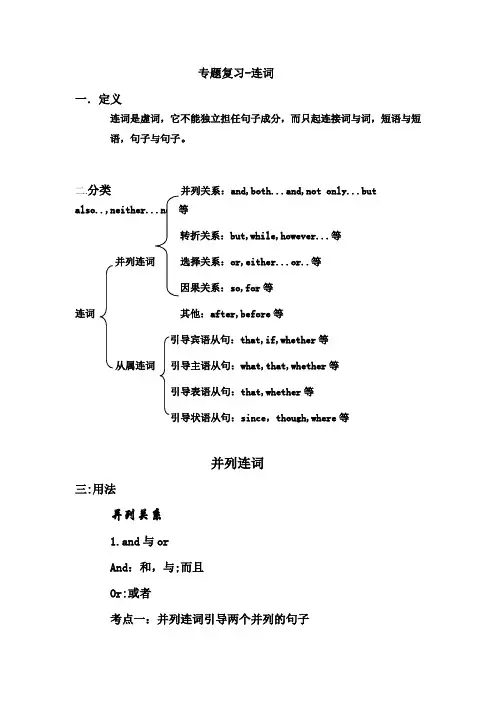
专题复习-连词一.定义连词是虚词,它不能独立担任句子成分,而只起连接词与词,短语与短语,句子与句子。
二.分类and,both...and,not only...butbut,while,however...等or,either...or..等so,for等连词其他:after,before等that,if,whether等从属连词what,that,whether等that,whether等since,though,where等并列连词三:用法并列关系1.and与orAnd:和,与;而且Or:或者考点一:并列连词引导两个并列的句子判断改错:(1)They sat down and talk about some thing.()(2)They started to dance and sang.()(3)I saw two men sitting behind and whisper there.()(4)They started to dance and sing.()(5)I saw two men sitting behind and whisperingthere.()考点二:and与or在祈使句中的应用。
Eg;Make your mind,and you`ll get the chance.One more effort,and you`ll succeed.Do it now,or you`ll miss the opportunity.Beg your father,or he will beat you.考点三:and与or在意义上的区别Your father_______my father are good friends.Do it______not,it`s up to you.1.both...and... 两者都She can speak both English and Chinese.2.Not only...but also...=as well as...注意:not only..but also连接两个分句时,第一个分句用到装(原因否定词位于句首)Not only does he like reading stories,but also he caneven write some.3.Neither...nor既不...也不....Neither you nor he is to blame.4.Either...or或者...或者...转折关系6.but与while转折和对比Some people love cats,while others hate them.试一试:Would you like to come to dinner tonight?I`d like to,__________I`m too busy.7.Not...but..不是...而是...They were not the bones of an animal,but(the bones)of a human being.原因关系8.for与becauseBecause+句子,常位于句首for放于两个分句之间,前面常有逗号隔开练习:判断对错1.For he is ill,he is absent today.()2.He is absent today,for he is ill.()3.I can not sleep because I am too excited.()注意:(1).for引导的从句不能位于它所解释的动词之前。
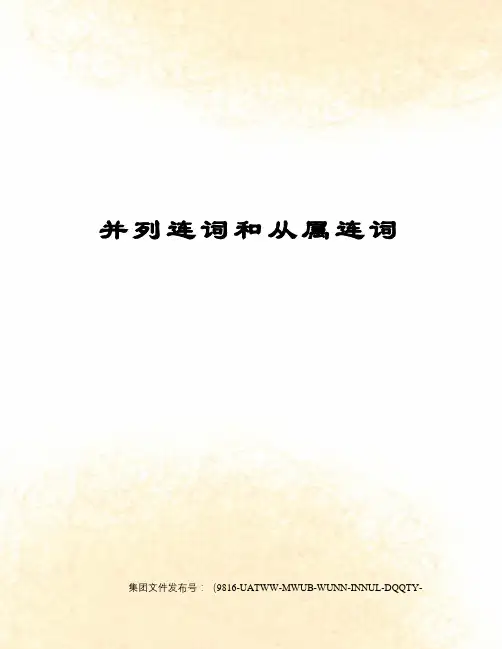
并列连词和从属连词集团文件发布号:(9816-UATWW-MWUB-WUNN-INNUL-DQQTY-一、并列连词:一)常见的表示语义延伸的并列连词有:1.andJusticeisonyourside.And justicewilltriumphoverinjustice.正义在你们一边,而正义是会战胜非正义的。
2.neither...norShecould neither speakthelanguage nor writeit.这种语言她既不会说,也不会写。
3.both...andAmanshouldhave both courage and perseverance.一个人既要有勇气又要有毅力。
4.notonly...butalsoWeshould notonly bebold,butalso becautious.我们不仅要大胆,而且要谨慎。
5.aswellasIhavereadoneofhisnovels aswellas afewofhisplays.我读过他的一本小说和几个剧本。
二)表示选择的并列连词有:1.orYoumaydoityourself,or asksomeoneelsetodoit.你可以自己做或者让别人做。
2.either...orIleftit either onthetable or inthedrawer.我不是把它放在桌子上了,就是放在抽屉里了。
除了表示选择外,or和either...or还可以表示否定的条件:1)NowImustgoor(ifnot)Ishallbelatefortheparty.我现在得走了,否则晚会我就要迟到了。
2)You'lleitherbehaveyourself,oryou'llnevergooutwithme.你要么老实点,要么就永远不能跟我一起出去。
三)表示转折或对比的并列连词有:1.butHetriedhard but hewasunsuccessful.他做了很大努力但没有成功。
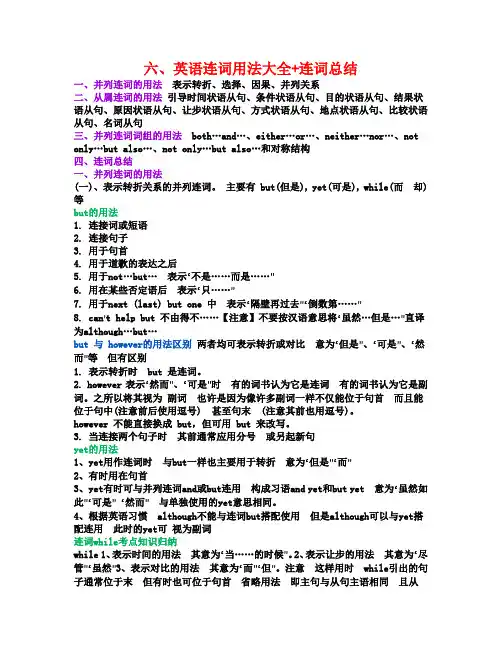
六、英语连词用法大全+连词总结一、并列连词的用法表示转折、选择、因果、并列关系二、从属连词的用法引导时间状语从句、条件状语从句、目的状语从句、结果状语从句、原因状语从句、让步状语从句、方式状语从句、地点状语从句、比较状语从句、名词从句三、并列连词词组的用法both…and…、either…or…、neither…nor…、not only…but also…、not only…but also…和对称结构四、连词总结一、并列连词的用法(一)、表示转折关系的并列连词。
主要有 but(但是), yet(可是), while(而却)等but的用法1. 连接词或短语2. 连接句子3. 用于句首4. 用于道歉的表达之后5. 用于not…but…表示“不是……而是……”6. 用在某些否定语后表示“只……”7. 用于next (last) but one 中表示“隔壁再过去”“倒数第……”8. can’t help but 不由得不……【注意】不要按汉语意思将“虽然…但是…”直译为although…but…but 与 however的用法区别两者均可表示转折或对比意为“但是”、“可是”、“然而”等但有区别1. 表示转折时but 是连词。
2. however 表示“然而”、“可是”时有的词书认为它是连词有的词书认为它是副词。
之所以将其视为副词也许是因为像许多副词一样不仅能位于句首而且能位于句中(注意前后使用逗号)甚至句末 (注意其前也用逗号)。
however 不能直接换成 but,但可用 but 来改写。
3. 当连接两个句子时其前通常应用分号或另起新句yet的用法1、yet用作连词时与but一样也主要用于转折意为“但是”“而”2、有时用在句首3、yet有时可与并列连词and或but连用构成习语and yet和but yet意为“虽然如此”“可是”“然而”与单独使用的yet意思相同。
4、根据英语习惯although不能与连词but搭配使用但是although可以与yet搭配连用此时的yet可视为副词连词while考点知识归纳while 1、表示时间的用法其意为“当……的时候”。
常用汉语连词一、并列关系1、既⋯⋯,也(又)⋯⋯:她既努力学,又极身体。
2、又⋯⋯,又⋯⋯:她又明,又努力。
3、也⋯⋯,也⋯⋯:儿子也睡了,妻子也睡了,只有他在看。
4、有(有候,有的候)⋯⋯,有(有候,有的候)⋯⋯:星期日我有看,有上网。
5、一会儿⋯⋯,一会儿⋯⋯:他一会儿用聊天,一会儿用聊天。
6、 a 、一⋯⋯,一⋯⋯(口):他一看,一聊天。
b.一面⋯⋯,一面⋯⋯(面)他一面跟客人打招呼,一面接客人手里行李。
7、 a 、一来⋯⋯,二来⋯⋯(口):做,一来可以更多的中国朋友,二来可以你的口。
b.一方面⋯⋯,(另,又)一方面⋯⋯:次到北京来,一方面想游北京的名古迹,另一方面也想看看多年不的老朋友。
c.一⋯⋯,二⋯⋯(面)二、关系1、或者(或,或是)⋯⋯,或者(或是)⋯⋯:午或者吃子,或者吃米。
2、要么⋯⋯,要么⋯⋯:要么去广州旅游,要么去上海旅游。
3、(是)⋯⋯,是⋯⋯:她是忘了,是故意不来。
4、不是⋯⋯,就是(便是)⋯⋯:件事不是你做的,就是她做的。
5、不是⋯⋯,而是⋯⋯:她不是口老,而是听力老。
6、宁可(宁肯,宁愿)⋯⋯,也不(决不,不)⋯⋯:我宁愿去,也不愿意坐去。
7、与其⋯⋯,不如(不如,倒不如)⋯⋯(口):与其在儿等他,不如先去呢。
8、与其⋯⋯,宁肯⋯⋯:(面)三、关系1、不但(不、不光、不只)⋯⋯,而且(并且,且)⋯⋯:他不但得,而且也很明。
2、不但不(不但没,非但不,非但没)⋯⋯,反而(反倒):吃了减肥以后,她不但没瘦,反而胖了。
3、⋯⋯,甚至(甚至于)⋯⋯:他不但不我,甚至我的名字都不知道。
4、⋯⋯,况且⋯⋯:上海那么大,况且你又不知道他的地址,怎么能一下子找到呢?5、⋯⋯,再⋯⋯ (口):儿的条件不怎么,再也太了,我是去的地方吧。
6、⋯⋯,何况(更不必,更不用)⋯⋯:个你都不会,何况是我呢?7、(不要,,不要)⋯⋯,就是(即使):个很,是我,就是她也不会。
四、折关系1、然(,)⋯⋯,但是(可是)⋯⋯:天气然么冷,但是我身上在出汗呢。
(Word) 译林版英语八年级下册连词表(Word完整版) 译林版英语八年级下册连词表连词是连接句子、词组或单词的重要词语,它们在句子中具有承接、转折、并列等功能。
本文档为译林版英语八年级下册的连词表,提供了常用连词及其用法,以帮助学生更好地理解和运用连词。
一、并列连词(Coordinating Conjunctions)1. 并列连词用于连接具有相同地位的两个或更多的句子、词组或单词。
常见的并列连词有:and, but, or, so等。
and, but, or, so等。
示例用法:- and: 表示并列关系,连接两个相同或相似的事物。
- I like apples and oranges.and oranges.- Tom and Jerry are good friends.and Jerry are good friends.- but: 表示转折或对比关系。
- He is young, but he is very talented.but he is very talented.- She wanted to swim, but it was too cold.but it was too cold.- or: 表示选择关系,用于提出两个或多个选项。
- Would you like tea or coffee?or coffee?- Do you want to go to the park or stay at home?or stay at home?- so: 表示因果关系,前后两个句子之间存在因果关联。
- I was hungry, so I ate the sandwich.so I ate the sandwich.- It was getting late, so I decided to leave.so I decided to leave.二、从属连词(Subordinating Conjunctions)2. 从属连词用于连接主句和从句,在句子中起到引导作用。
并列连词与从属连词表示并列关系●表示并列关系的连词主要含有“和”、“补充”、“增加”等意思。
用来表达并列关系的连词有如下几个:and、both...and... 、either...or...、neither...nor...、as well as、not only...but (also)...●表示转折关系常用来表示转折关系的并列连词有如下几个:but、yet、however、still、while●表示选择关系表示选择关系的并列连词:or、or else、otherwise、neither...nor...、either...or...●表示因果推理关系表示因果关系的并列连词主要有so,for,then,therefore 等。
从属连词从属连词是连词的一种,用来引导名词性从句和状语从句。
从属连词可分三大类:1、that (无词义,不做成分)if、whether(表达是否的意义,但不做句子成分)2、连接代词:who、whom、whose、what、which、whatever、whoever、whichever(有词义,在句子中可作主语、表语、宾语)3、连接副词:when、where、why、how、how many、how long、how far、however、whenever、wherever(有词义,作从句的状语)初一英语人称代词与物主代词专练一、按要求写出下列代词的形式1、I(宾格)2、he(形容词性物主代词)3、us(主格)4、they(宾格)5、she(宾格)6、you(名词性物主代词)7、it(宾格)8、him(复数)9、her(形容词性物主代词)10、my(复数)11、they(名词性物主代词)12、we(单数)二、用括号里的代词的适当形式填空1,Mr Yang is _______(we) teacher.________(him) is from Beijing._______(his) teaches______(our) English.2,Look,there is a cat._______(they) is Lily's.____(it) name is Mimi.3,Let______(I) tell ______(she) about_____(he) life at school.4,This is ______(they) rooom.Where is _____(our)?5,Don't use the eraser.______ is ______(me).6,The lady under the tree is ______(me) aunt._____(her) often sings with _____(she) husbandI.用be的适当形式填空1.---How____ you? ---I____ fine.2.I___ David,and my family name___ Green.3.---What color ___ your clock? ---It___ white.4.---What___ this in English?---It___ an apple.5.Toy___my brother.David____my brother,too.They ___ my brothers.6.Look!These____apple trees.7.We____ good students and you____ good teacher.8.My sister and my brother_____ students.9.Five and three ____ eight.10.____your card number 5578?11.Where_____ your pencils?12.Thses sweaters ______ fifty dollars.13.How much ____ his jacket?14.My brother’s birthday____ December 11th.15.When _____ Kate’s birthday?。
并列句和状语从句并列连词用来连接双方是并列关系的词、短语、从句、或句子。
常见的并列连词有and,but,or,nor,for(因为),as well as(和,也),both。
and,either。
or(或者。
或者),neither。
nor(既不。
也不),however,nevertheless (然而),so,therefore(因此),yet,not only。
but also(不但。
而且),then,while (而)等。
1.我们钓了一天鱼,但是我们一条鱼都没有钓着。
2.没有消息,然而他继续抱有希望。
3.你最好把毛衣穿上,因为外面很冷。
4.树木被砍完了,所以泥土被水冲走了。
5.你是学生而我是老师。
6.我们又说又笑。
7.我们要加倍努力,否则永远也赶不上别人。
8.你和他身体都不好。
9.他既不求名也不求利。
10.他既不会讲法语,也听不懂法语。
11.你可以坐公共汽车去也可以打的去。
12.酒后驾驶(drunk-driving)不仅会造成交通事故,而且会危及到人的生命。
13.John 和Tom 都来自美国。
14.鲁迅是一位作家也是一位思想家。
从属连词主要用来引导状语从句,状语从句可以表示时间、地点、原因、结果、目的、方式、条件、让步等意义。
(主句+ 状语从句(从属连词+句子))常见的从属连词:时间状语从句:when while as before after since,till/untilthe moment地点状语从句:where原因状语从句:because(因为)since(既然)as (由于)seeing that=now that因为由于结果状语从句:so。
that such。
that so that(以至)目的状语从句:in order that so that(为了,以便)lest =for fear that (以免)方式状语从句:as like (象)as if = as though(好象)条件状语从句:if once so long as=as long as on condition that(条件是)in case如果万一suppose =supposing (假如,万一)(用语口语中)provided=providing (如果)用于正式文体让步状语从句:though although(尽管)even if=even though(尽管)no matter +wh。
语法填空答题规律一、命题揭秘材料短文特点(1)短文体裁:近三年都是记叙文。
建议:备考练习不局限于此应各种体裁的文章都要练习。
(2)短文题材:生活经历或成语故事,其内容或体现文化内涵,或给人心灵以启迪等。
(3)短文难度:没有超出课标的生词,但有课标单词的派生词。
(4)短文长度:170——200词。
考试大纲说明阅读下面短文, 按照句子结构的语法性和上下文连贯的要求, 在空格处填入一个适当的词或使用括号中词语的正确形式填空, 并将答案填写在答题卡标号为31~40的相应位置上.2009年语法填空本文讲叙Jane在圣诞节给父亲选礼物,因往年送父亲领带不能使父亲高兴,满以为这次买烟斗送父亲会让父亲高兴的,买回来后却被告知父亲戒烟了。
Jane was walking round the department store. She remembered how difficult 31 was to choose a suitable Christmas present for her father. She wished that he was as easy 32 (please) as her mother, who was always delighted with perfume.31. it。
在宾语从句中作形式主语,真正的主语是to choose…。
32. to please。
在形容词后作状语,只能用动词不定式,且用主动形式表示被动含义。
Besides, shopping at this time of the year was not 33 pleasant experience: people stepped on your feet or 34 (push) you with their elbows (肘部), hurrying ahead to get to a bargain.Jane paused in front of a counter 35 some attractive ties were on display. “They are real silk,” the assistant tried to attract her. “Worth double the price.” But Jane knew from past experience that her 36 (choose) of ties hardly ever pleased her father.33. a。
并列连词和从属连词连词是一种虚词, 它不能独立担任句子成分而只起连接词与词,短语与短语以及句与句的作用;连词主要可分为两类:并列连词和从属连词;并列连词用来连接平行的词、词组和分句;如:and, but, or, nor, so, therefore, yet, however, for, hence, as well as, both…and, not only…but also, either…or, neither…nor, andthen等等;1. 并列连词并列连词用来连接属于同一层次并具有相同句法功能的词;短语或句子;并列连词包括:基本并列连词如 and, or , but , 关联连词如 either...or , neither...nor , not only...but also ,both ...and, whether...or 等;介于并列连词与从属连词之间的连词;介于并列连词与从属连词或介词之间的结构如as well as , as much as, rather than , more than, no less than 等;此外还有些'半连接词',一些语法学家把它们称为连接副词,如 nevertheless, however, meanwhile, otherwise, likewise 等,它们在句中做连接性状语;这类连词主要是从逻辑上,而不是从形式上连接句子,其关系比较松散;1 表示意义转折和对比的并列连词常见的有:but , while, whereas, still, yet , nevertheless, likewise, anyway , only , conversely , on the contrary, by this time, all the same , fortunately, on the other hand , in the meantime 等词语;2 表示选择的并列连词常见的有: or, whether...or, either...or, otherwise 等;例如:Either ...or 和 whether...or 表示选择,其意义比单用 or 要强,但由whetrher...or 构成的并列结构一般只能担任句子的从属成分;上例中最后一句,whether...or 结构在句中担任句子的从属成分; Either ...or 和 or 一样,可以连接两个并列的独立分句,而 whether...or 则不可以; or 用于表示否定的条件意义时,有时可与连用;Or 连接主语时,如主语都是单数,动词则取单数形式;如主语都是复数,动词则取复数形式,如果主语有的是复数,动词则取复数形式,如果主语有的是单数,有的是复数,动词的数则与它靠近的主语的数相一致;连接两个主语时,动词的数也应与靠近他的主语的数相一致;例如:Neither he nor I am a good student.3 表示因果意义的并列并列连词常见的有: for ,so ,therfore ,hence ,thus, accordingly, consepuently, on that account, in that case 等;例如:The fuel must have beeenfinished, for the engine stopped.It rained , therefore the game was called off.表示原因的并列连词只有 for ,它所引导的分句只是对前一分句补充说明理由或推断原因; for 引导的分句只能置于句末,而且必须用逗号与前一分句隔开;上面所提到的 so,therefore 等词,有的语法学家把它们做为连接性状语;4 表示联合关系的并列连词常见的有: and, both...and, neither...nor, not only... but also 等;当 neither...nor, not only ...but also 连接主语时,动词的数则与靠近它的主语的数相一致; Both ...and 不能连接两个以上的并列成分,也不能连接分句;例如:误:Both Mary swept the floor and Nancy mopped it.5 其它并列连词常见的有: as well as, more than, rather than, no less than 等.1 as well as 表示 '同' 和 '也' 的意义as well as 用作并列连词时它意义相当于 not only...but also, 但侧重点在后一并列成分上而 as well as 侧重点却在前一并列成分上 ,A as well as B=not only B but also A.2 more than 表示而不是之意. 例如:3 rather than 表示 '而不是' 之意.4 no less than 表示 ' 同 ... 一样 ' 之意.当 as well as ,more than, rather than, no less than 连接两个成分作主语时谓语动词应于第一个成分的数相一致. 在使用并列连词时我们应该注意:1 并列连词不可以连用.2 有些连接性状语副词可以和某些从属连词对应使用.3 在 for 或 so that 引出的分句中如果主语与前一分句的主语所指相同其主语不可以省略. 同样, 如果第二个分句是由连接副词引出的其主语通常也不可省略. 例如:2. 从属连词从属连词用来引导名词从句和各类的状语从句;从属连词按词形分为简单从属连词,复合从属连词,关连从属连词;1 简单从属连词常见的有:after, although, as, because, before, if, lest,once, since, that, till, unless, until, when, where, whether, while 等;例如:2 复合从属连词由两个或两个以上单词构成的从属连词,如: as if, as far as , as soon as, according as , in case , no matter whohow,what,when, where, rather than, for all that , given that, in order that, now that, on condition that , so that ,provided/providingthat, inasmuch as , insofar as 等;3 关联从属连词由两个关联构成的,如: as...as, noreless,-er...than, no sooner...than, so ...as , so...that,such...sa , the...the, whether...or 等,使用从属连词时,应该注意1 由从属连词引导的状语从句,其位置通常是可变的;2 并列连词之间之前不可以加其它连词,而从属连词之前可以加并列连词;连接副词;使用连词时, 还应该注意:1. because, for, since, as 的区别because语气强, 表示客观必然原因:例如: He is absent, because he is ill. 因为生病,所以他没来;比较:He is absent, for he is busy. “生病”是“缺席”的必然原因,“忙”不是必然原因;for 语气轻,表示非客观必然的原因,是主观可改变结果的原因,甚至是猜测可能的原因:He must be ill, for he is absent. “缺席”不一定是“生病”,只是交流猜测; for 不能放句首,它是并列连词.since, as 都是不讲自明的原因, 是已知的原因.Since I am a boy, let me carry the case.As you don't feel well,you had better stay at home.综观近几年全国各省市的高考题,我们发现均加大了对连词应用的考查;由此可见连词在英语学习和运用中的重要性,下面我们结合相关的例句和知识点来分析和掌握连词的考查方向和内容;一、并列连词1. 表并列关系联合关系: and, but, not…but, not only…butalso, neither…nor等;注意1 both…and两者都……,连接句子的两个主语时,其后谓语动词通常用使用复数形式;not only…butalso与neither…nor则采取“就近原则”;如: She plays not only the piano, but also the guitar.Neither you nor he is to blame.注意2 not only…but also与as well as 两者强调对象不同: not only…but also强调的是but also之后部分,而as well as则强调其前面的部分;谓语动词单复数判断上not only…but also采取“就近原则”,而as well as,则采取“就远原则”;如: Mr. Smith, as well as his wife and children, has come to Nanjing for a visit.注意3 not only…butalso结构中的not only可用于句首引导从句,在这种情况下该从句的主语和谓语要倒装;如: Not only is he clever, but also he is hard working.Not only did we write to her but also we telegraphed her.2. 表转折关系: but, yet, still, while, however, when等;注意4 while可以表示“尽管、即使”;另外,while还可以表示两者进行对比的用法;如: Bob likes playing basket ball, while his brother likes football. She has difficulty in learning English, however, she works hard and is making rapid progress.3. 表选择关系: or, otherwise, or else, either…or等;注意5 either…or句型中谓语的单复数形式也要采取“就近原则”;如: We must hurry, or we’ll miss the train. Either Jim or you are going to attend the course.4.表因果关系: for, since, because, as, so, thus, therefore, and so 等;如: We had better stay at home, for it was raining.He didn’t work hard, therefore he failed in the examination.He was late for class because he got up late.二、从属连词1. when, while, as都表示“当……时候”: when引导的从句的动作与主句的动作可同时发生,也可先后发生; as和while引导的从句则强调主句和从句的动作同时发生;如: When I got to the station, the train had already left. He sang merrily as he was working.2. till, until均表示“到……时候为止”,肯定句中的谓语必须是延续性动作;若主句谓语是终止性动词,则主句要用否定形式,意为动作“到……才……”开始发生;如: I worked till late at night. She didn’t get up until her mother came in.注意6 till和until通常情况下可以互换,只是在句首时until比till更常用;3. though, although均引导让步状语从句,意为“虽然……”,但although 较正式,though最常用;如: We had to wait half an hour although we had already booked a table.注意7 though和although引导的从句不能与but/however连用,但可以与yet/still连用;though还可以与别的词结合使用,如even though/as though, although则不能这样搭配;4. no sooner…than, hardly…when, as soon as三者都表示“一……就”,“刚刚……就”的意思;注意8 as soon as 置于主句前后都可以,而且各种时态均可作用;如: As soon as she gets here I’ll tell her about it.注意9 hardly…when, no sooner…than不能表示将来的事,其主句的谓语动词一般用过去完成时,从句则用过去时;若将hardly或no sooner放在句首,句子要倒装;如: She had hardly reached there when it began to rain.5. 某些表示时间的名词词组也可用作从属连词引导时间状语从句;它们是:the moment, the minute, the instant, the day, the time, the first second, third…time, the spring summer, autumn, winter, everyeach, next, any timeday, by the time等;如: His mother died the spring he returned. Call me up the minute he arrives.6. if, once, unless, in case四者都表示“条件”,但if意为“如果、假使”;once意为“一旦”;unless意为“除非”;in case意为“万一、以防”;如: I won’t call you, unless something unexpected happens. Once you begin, you must continue.7. after, since, till/until, before这些词既是介词,又是连词;如: The children went home at once after school. They went to bed after they had finished the job.并列连词 when 和引导时间状语从句的从属连词 when 是不同的;这主要表现在以下几个方面:1. 位置: when 引导时间状语从句时,该从句可放在主句之前也可放在主句之后;而并列连词 when 只能位于两个分句之间,而且前面常常有逗号;例如:Come when you please. 你高兴来就来吧; when 为从属连词When I saw him,he was writing to a friend of his.我看见他时,他在给一个朋友写信; when 为从属连词I was taking a walk, when I came across him. 我正在散步,突然碰见了他;2. 意义: when 作从属连词用时,它所引导的从句表示主句中谓语动词动作发生的时间,即作“当……时”解;而并列连词 when 连接的两个分句中,第一个分句表示的是背景,第二个分句表示的是一种突然的、意想不到的情况或过早发生的事情; when 通常含“这时突然”之义;例如:I was thinking of this, when I heard my name called. 我正想着这件事,突然听到有人叫我的名字;I had just fallen asleep, when the boor-bell rang. 我刚入睡,门铃突然响了起来;这种意义在孤立的句子中可以理解到,在文章中更能体会得到;如在“ I was wandering through the street when I caught sight of a tailor's shop ”一句中,“在街头漫步”只是“看见有家缝纫店”的时间,其后作者怎样走进缝纫店,想要什么样的衣服,怎样受到伙计的奚落,又怎样受到老板的奉承等情景均与“漫步街头”没有直接的因果关系;3. 时态: when 引导的时间状语从句中可以根据句意的需要用一般现在时、一般过去时、过去进行时、分别说明现在,过去,甚至将来的行为;并列连词 when 后面的分句中通常用非延续性动词的一般过去时,其前表时间的分句中可用:1 过去进行时表示过去某时间正在进行的动作;例如:I was cooking when I heard her knocking at the door. 我正在做饭,突然听到她敲门的声音;He was thinking about the problem, when an apple fell to the ground.他正在思考这个问题,突然有一只苹果掉到了地上;2 was /were going to, was / were about to, was / were on the point of 表示过去某一时间将要发生的动作;例如:I was just going when he came in. 我正要走,这时他就进来了;We were about to start when it began to rain. 我们刚要动身天就开始下起雨来了;He was on the point of leaving, when someone knocked at the door. 他刚要走就有人敲门;3 过去完成时表示过早发生的事情;请看下述两种场合:a 过去完成时和含否定意义的 hardly, scarcely, nearly 连用,和just, little 连用,或者与否定词 not 连用时,表示“刚……,就……”的意思;例如:I had hardly opened the door when he hit me. 我刚一开门他就打了我一下;I had nearly reached the town, when the young man suddenly said very slowly, “ Do you speak English ”我快要进城了,年轻人突然慢慢地说:“你会讲英语吗”I had been there little more than a week when I set to work in earnest.我到那儿还不超过一个星期就开始认真干起活来;I had not been reading for half an hour when I heard steps outside.我读了还不到半个钟头就听到外面有脚步声;b 过去完成时与 hardly 等连用时, when 也可以换成 before .例如:Hardly had I left before the trouble started. 我刚一离开麻烦就开始了;4. 句型: when 引导状语从句时,主句可以是肯定句,也可以是疑问句形式,但 when 连接两个并列分句时,其前的分句只能是肯定句,即只能是不带否定副词 not 的分句;前文 3 a 最后一个例句算是一个例外;试比较:Mick was sleeping when they went in.并列句迈克正在睡觉,他们突然走了进来;When they came in Mick was sleeping. 主从句他们进来时迈克正在睡觉;“ Was Mick sleeping when they came in ”和“ What was Mick doing when they came in ”只能是对其中主句的提问,因为这时 when 所引导的分句既无突然性也不是句子中的未知信息,而只是另一个动作发生的特定时间;。
一、并列连词:一)常见的表示语义延伸的并列连词有:1. andJustice is on your side. And justice will triumph over injustice. 正义在你们一边,而正义是会战胜非正义的。
2. neither... norShe could neither speak the language nor write it. 这种语言她既不会说,也不会写。
3. both... andA man should have both courage and perseverance.一个人既要有勇气又要有毅力。
4. not only... but alsoWe should not only be bold, but also be cautious. 我们不仅要大胆,而且要谨慎。
5. as well asI have read one of his novels as well as a few of his plays. 我读过他的一本小说和几个剧本。
二)表示选择的并列连词有:1. orYou may do it yourself, or ask someone else to do it. 你可以自己做或者让别人做。
2. either... orI left it either on the table or in the drawer. 我不是把它放在桌子上了,就是放在抽屉里了。
除了表示选择外,or和either... or还可以表示否定的条件:1) Now I must go or (if not) I shall be late for theparty. 我现在得走了,否则晚会我就要迟到了。
2) You'll either behave yourself, or you'll never go out with me. 你要么老实点,要么就永远不能跟我一起出去。
三)表示转折或对比的并列连词有:1. butHe tried hard but he was unsuccessful. 他做了很大努力但没有成功。
2. yetThe car was old, yet it was in excellent condition. 这辆车子很旧,但仍处于良好的状态。
3. howeverShe felt ill. She went to work, however, and tried to concentrate. 她病了。
然而她照旧去上班,并且尽力集中精神工作。
四)表示因果关系的并列连词有:因果:原因和结果1. forYou'd better put on your sweater, for it's rather cold outside. 你最好把毛衣穿上,因为外边相当冷。
2. soMy sister is expecting me,so I must be off now. 姐姐在等我,因此我得走了。
二、从属连词:从属连词是用来引导从句的。
一)引导时间状语从句的从属连词有:1. whenThere was prolonged applause when he began to speak. 他开始讲话时响起了经久不息的掌声。
2. whileWe should strike while the iron is hot. 我们要趁热打铁。
3. asAs (When) he entered, the hall burst into thunderous applause. 当他进来时,全场发出雷鸣般的掌声。
4. afterAfter I visit Shanghai I'll travel up the Yangtze. 访问上海之后,我将溯长江而上。
5. beforeIt would be months before he was fit for the work. 要过好几个月他才能适应工作。
6. sinceIt is just a week since we arrived here. 我们到这里才一个星期。
7. until (till)I shall stay here until (till)I've completed my studies. 我要在这里待到学习结束为止。
8. as soon asAs soon as he got well, he went back to work. 他病一好就回去上班了。
9. onceOnce he said that, I knew he was lying. 他一说这话我就知道他在撒谎。
二)引导原因状语从句的从属连词有:1. becauseHe failed because he was too careless. 因为他太粗心,所以失败了。
2. asAs it was already rather dark, we decided to stop at the temple for the night. 因为已经相当晚了,我们决定在庙里待一夜。
3. sinceSince(原因)you don't want to go, we won't force you to. 既然你不愿意去,我们也不勉强你。
4. now thatNow that you are all back, we'd better start the work right away. 你们既然都回来了,我们最好马上就开始工作。
5. considering (that)They did the job quite well considering (that)they had no experience. 考虑到他们没有什么经验,这项工作他们已经干得不错了。
6. seeing thatSeeing that (Since)nobody was very enthusiastic about it, they decided to cancel the trip. 由于都没有很高的热情,他们决定取消这次旅行。
七)引导结果状语从句的从属连词有:1. so...thatShe was so moved that tears came to her eyes. 她感动得热泪盈眶。
2. such...thatIt was such a boring speech that I fell asleep. 演讲枯燥乏味,听得我都睡着了。
三)引导条件状语从句的从属连词有:1. ifIf you can do it, so can I. 你要是能办到,我也能办到。
2. even ifWe wouldn't lose heart even if we should fail ten times. 我们就是失败十次也不灰心。
3. unlessI won't go unless you want me to. 除非你要我去,否则我是不会去的。
4. in caseWe'd better take our raincoats in case it should rain (rains). 我们最好把雨衣带着以防下雨。
5. provided /providing (that)I'll come provided (providing) (that) you let me know in good time. 你要是及时通知我是会来的。
6. suppose/supposing (that)Suppose (Supposing) (that) he won't agree, what shall we do? 假如他不同意,我们怎么办?7. as (so) long asYou may use the room as long as you keep it clean.只要保持清洁你可以用这个房间。
8. on condition (that)I'll lend you the book on condition (that) you return it on Monday. 只要你能在星期一还我,这本书我就借给你。
四)引导让步状语从句的从属连词有:1. although / thoughEverybody worked with great enthusiasm although/though the weather was extremely cold. 虽然天气很冷,大家工作得非常起劲。
2. even if (though)Even if I have to walk all the way I'll get there.即使我得一路走着去,我也要去那里。
五)引导比较状语从句的从属连词有:1. thanWe have produced 20% more cotton this year than we did last year. 我们今年棉花产量比去年高百分之二十。
2. as (so)...asHe doesn't play half as well as his sister. 他演奏的水平不及他姐姐的一半。
六)引导目的状语从句的从属连词有:1. lestShe explained again and again lest people should misunderstand her. 她一再解释唯恐人们误解。
2. so thatSpeak clearly so that we may understand you. 讲话要清楚,以便我们能听明白。
3. in order thatHe assigned us some books to read at home in order that (so that) we might have a deeper understanding of the subject. 他指定几本书给我们回家看,以便我们对这一主题有一个较深的了解。
八)引导名词性从句的连词有三个:(1)that (本身无意义),(2)whether (or not),(3)if。
例如:That they will refuse the offer is unlikely. 他们不太可能会拒绝这个建议。
I don't know whether (=if) these figures are accurate. 我不知道这些数字是否精确。
需要注意的是:whether (or not) 可引导大部分名词性从句;if仅可引导宾语从句,而且不可跟or not。